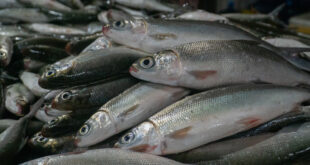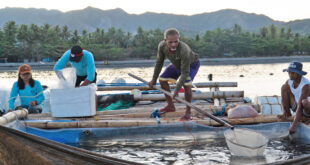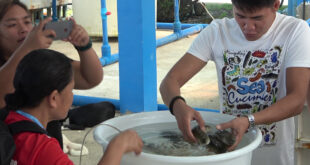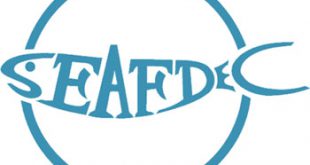 Technology description
Technology description
To produce food through aquaculture without sacrificing the environment is an apt description for the culture or fattening of mudcrab in mangrove areas. The use of net enclosures in mangroves or tidal zones offers a better alternative to pond culture. It also promotes a better image for brackishwater aquaculture that had been linked to the historical clear-cutting of mangroves to make way to ponds.
For fattening, the technology involves the construct of small cages with individual cells which are then stocked with lean crabs, weighing at least 100 g (if female native crabs) or 300 g (if female giant crab). Males weighing 200 g (if native) or 350 g (giant crab) may also be stocked individually in the cage cells. Fattening can take 15-30 days.
Pen culture of mudcrab, on the other hand, entails the enclosure of mangrove stands with bamboo-supported netting. The shape of the enclosure may be irregular, depending on the location of the mangrove trees. Or, rectangular net pens may be constructed, complete with walkways, particularly in or around new reforested mangrove areas. Culture can take 150 days.
The crab farmer follows a protocol in taking care of the stock, from stocking to feeding to selective harvest.
The culture system used is monoculture in cell-type cages or pens, and may be implemented in mangrove areas. Medium-sized crabs to be used for stocking may be obtained through crab trapping or from fishponds. Feeds, usually trashfish, are bought in from the local market.
| Technology profile: | |
 Fattening in cages with individual cells Fattening in cages with individual cells(1) Construct a bamboo cage (0.25 x 0.7 x 2m;) with a green nylon net (12 mm mesh size) for side walling, bottom flooring and top movable cover. Make three main divisions, further dividing into eight cells. A cage would have 24 cells. Provide cage with floats and rings in the corners. (2) Set or stake the cage at the fringes of the mangrove area, such that, at the lowest tide, ¾ of the cage is still submerged. Cover cage with coconut fronds as crab shelter. (3) Stock one crab per cell, and feed with trash fish or mixed diet of 75% brown mussel meat and 25% trash fish at 10% of the crab biomass per day. (4) Selectively harvest and restock harvested cages. Fattening can take 15-30 days. |
|
| Pen culture in mangroves (1) Construct net enclosures with bamboo as structural support, and line the inner side of the upper end with plastic sheet to prevent crabs from escaping. The bottom of the net is buried in the ground. Height of the enclosure should be 30-40 cm above the highest tide. (2) Of the 0.2 ha area, allocate 20-30% to peripheral and central canals (100 cm wide x 50 cm deep). Dig the canals between mangroves without damaging main roots. Canals are intended to retain 50 cm water during lowest tide. Allow water to flood and drain with the tides. It is important for mangrove roots to be exposed as continuous submergence will cause their death. (3) Acclimate crabs by pouring seawater over them. Sort males from females, and stock separately. Stock similar-sized crabs of the same species in the same pen to reduce fighting and cannibalism. Stock at 5,000 lean crabs per ha. (4) Monitor water quality, watch for signs of diseases and abnormalities, and feed the crabs. Feeds used include trashfish and mussel meat which are given at 10% of crab biomass per day. Give 40% of the feed early in the morning and the rest in late afternoon. (5) Do monthly weight and carapace length measurements to adjust feed ration. (6) Selectively harvest marketable-sized crabs. |
|
References:
Agbayani RF. 2001. Production economics and marketing of mud crabs in the Philippines. Asian Fisheries Science 14:201-210
Baliao DD, de los Santos MA, Franco NM. 1999. Mudcrab, Scylla spp, production in brackishwater ponds. Aquaculture Extension Manual No. 28, SEAFDEC Aquaculture Department, Tigbauan, Iloilo. 14 p
Baliao DD, de los Santos MA, Franco NM. 1999. Pen culture of mudcrab in mangroves. Aquaculture Extension Manual No. 26, SEAFDEC Aquaculture Department, Tigbauan, Iloilo. 10 p
Mudcrab culture. 1999. A 3-fold flyer downloadable from the SEAFDEC/AQD website www.seafdec.org.ph/publications_downloadable.html
Mudcrab culture. SEAFDEC Asian Aquaculture 19 (3, August 1997): p 10-25
Primavera JH, Garcia LMB, Surtida MB, Castanos MT. 2000. Mangrove-friendly aquaculture. SEAFDEC Aquaculture Department, Tigbauan, Iloilo. 217 p
Triño AT, Rodriguez EM. 2001. Mud crab fattening in ponds. Asian Fisheries Science 14:211-216
Trino AT, Rodriguez EM, Coniza EB, Juanga BP. 1999. Mudcrab. Aquaculture Extension Manual No. 27, SEAFDEC Aquaculture Department, Tigbauan, Iloilo. 34 p
 SEAFDEC/AQD Southeast Asian Fisheries Development Center | Aquaculture Department
SEAFDEC/AQD Southeast Asian Fisheries Development Center | Aquaculture Department



